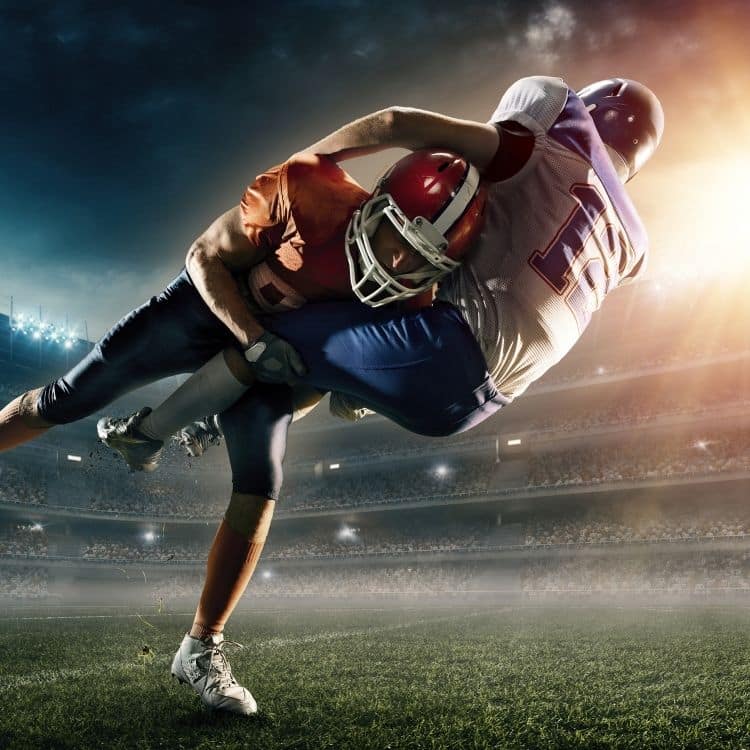
Many people wonder how hard gymnastics really is compared to other sports. In this article, I will analyze different elements of both gymnastics and football in an effort to give a clear (and unbiased) view of each sport.
Ultimately any answer to the question of which sport is harder will be based on a person’s opinion. Maybe you have experience and passion for one particular sport, but this can get in the way of giving a fair answer. So quick disclaimer… I am a gymnastics coach with no experience of teaching football but I have tried my best to approach this topic with an open mind!
To reach the top of any sport is an amazing achievement but let’s compare how hard it is to be successful in gymnastics and football.
Training volume
In order to make a fair comparison, we will focus on elite athletes in both sports.
Gymnastics
For gymnastics, you are considered truly elite if you are part of a national squad and competing in international competitions such as the World Championships or the Olympics. In the US, you must surpass level 10 and meet the set requirements.
An elite artistic gymnast will train around 40 hours per week which is the equivalent to most full-time jobs.
Artistic gymnasts tend to have the highest training volume of all the disciplines as they need to prepare for multiple apparatus (women have four and men train six). Other gymnastics disciplines such as Tumbling, Rhythmic and Trampoline focus on one apparatus and can reach an elite level with a lower training volume.
Artistic training schedules typically involve multiple sessions that are at least 3-4 hours long and spread over 6 days per week. Some days can involve double sessions such as an early morning plus an evening. Gymnasts are training year-round and this volume of training has to be very consistent to keep muscle memory levels high. The only times that the training volume might drop is immediately after a big competition to allow for some rest and recovery.
Football
NFL players are professionals and are also training and playing full-time. Not all NFL players may be considered elite within the game but they make a fair comparison in terms of levels within their respective sports.
During the regular season, players will be playing a match at least once a week, with up to five days of training and Tuesdays earmarked as a day off for all teams. The schedule is hectic and the volume of training can be high as games come around so quickly each week.
Some days at the training facility will begin before 8 am and finish after 6 pm. Other days may be shorter to due travel plans for away games or players needing rehab on injuries.
Even on Tuesdays, you’ll find most players still training at home or away from the facility even though it’s their ‘day off’.
The regular season may only run for 17 weeks per year but the playoffs follow for some teams and of course the Superbowl for the two remaining teams. Once the season finishes, players will have a few weeks of recovery time before restarting training for the new season. The volume of training will be 4-5 days per week either at a professional facility or with a personal trainer. The off-season has to be spent getting in shape or players risk getting dropped before the season even starts.
Hardest Training Volume: Gymnastics
Intensity of training
So now we have established the volume of training and typical schedules, it’s time to focus on how intense training is for both sports.
Gymnastics
Gymnastics training is based on repetitive attempts of skills and routines. One specific skill can be repeated dozens of times in a single session just to improve one element of the technique. It can be intense at times, especially if the gymnast is having difficulties or a mental block. There is a culture among certain types of gymnastics coaches to be deliberately harsh and demanding. Some gymnasts respond well to this, but many do not especially given the young average age.
Just before a competition, training should become less intense and more focused on improving small details or errors.
Football
Depending on the day of the week, training sessions will have varying levels of intensity. The day after a game will usually focus on video analysis of the previous game and trying to identify areas of improvement. Wednesdays and Thursdays will be more intense as teams go in-depth with the new game plan for the upcoming game on the weekend. Fridays are often shorter and are used to refine the details of the strategies about to be used.
Often it’s the time leading up to a new season that will have the most intense training sessions as players need to get into peak physical condition quickly. Organized Team Activities (OTAs) usually begin in April and players risk getting dropped if they are not physically ready by then.
Hardest Training Intensity: Gymnastics
Are Gymnasts Stronger than Football Players?
Which physical attributes do you need to be successful in each sport and which ones are hardest to achieve?
Here are ratings out of 10 for each attribute and how important they are in each sport
| Attribute | Gymnastics | Football |
| Stamina | 4 | 7 |
| Strength | 7 | 10 |
| Power | 8 | 9 |
| Speed | 4 | 8 |
| Agility | 9 | 8 |
| Flexibility | 10 | 5 |
| Quick Reaction / Response | 7 | 8 |
| Dynamic Balance | 8 | 9 |
| Static Balance | 9 | 4 |
| Total | 66 | 68 |
Although it’s close, Football just shades it for me in terms of overall physical requirements to reach the top of the sport. Requirements will differ slightly depending on the playing position of a football player or if a gymnast has a specialty apparatus on which they concentrate on. But this gives a general picture of what’s needed in each sport.
Hardest Physical Attributes: Football
Competitive pressure
These are two very different sports when it comes to competition (and yes gymnastics is a real sport).
Gymnastics
Most gymnastics competitions are scored individually and it’s the judge you have to impress. Some competitions combine scores to give an overall team result. In the Olympics for example there are both categories.
Even if your score is contributing to a team score, you will always be performing your routine alone. The only exceptions to this are pairs and groups in Sports Acrobatics (balancing on top of each other), Syncro in Trampoline or Team Gym which is mainly competed in Europe. Team Gym involves a team floor routine plus tumbling and trampette which is streamed. Streaming basically means gymnasts go one after each other in quick succession.
In terms of pressure, gymnasts are used to being out there on their own which can be lonely but if you do make a mistake, there’s only one person who will be let down and that’s the gymnast themselves.
Football
Two huge differences stand out when it comes to competitive pressure and football
- The team dynamic
- The huge audience
When you play any team sport there is the added pressure of letting down your teammates if you make a mistake. One dropped ball or missed kick can result in a loss, the impact of which will be felt not just by you alone. And it’s a constant pressure throughout the game of needing to concentrate and stay focused for fear of being the one who lets the team down.
NFL stadiums are huge and millions more will be watching games on TV around the globe. This adds huge pressure onto the players as they know every move they make will be analyzed over and over again. The only gymnastics competitions that are anywhere near comparable to this are the Olympics and World Championships.
Hardest Competitive Pressure: Football
Chance of making it pro
According to Leagueside.com, there are 1,093,234 high school Football players in the US. Subsequently, 71,060 will play in college but only 1.2% of college players will get drafted to the NFL.
That’s roughly 853 people each year making it as a pro footballer out of almost 1.1 million players (0.00075%).
Until recently, going Pro in gymnastics was not as straightforward as Football or other major sports. Becoming a pro meant not being able to compete in the strict amateur collegiate or NCAA gymnastics. To turn professional, a gymnast had to be very certain of podium success at the Olympics, and the endorsements and sponsorship that went with it. In July 2021 12 US states passed laws allowing college gymnasts to also profit from their name, image and likeness (NILs).
In effect this now allows top young gymnasts to turn pro, make money and still fill ambitions of competing in the NCAA program. Exactly how many more gymnasts will effectively turn pro is yet to be seen.
According to statista.com there were around 4.8 million active gymnasts in 2018. USA Gymnastics has a membership of around 148,000 athletes at a competitive level. This includes high school (roughly 19,000 gymnasts) and college gymnasts (around 1,500).
If we include all collegiate gymnasts both those on scholarships and those who will now earn from NIL payments that means around 1,500 from 4.8 million gymnasts actually training as full-time gymnasts (0.0003%).
The likelihood of going pro in either sport is small, but it’s much less likely in Gymnastics mainly due to the greater commercial pull of Football in the US.
Hardest Chance of Going Pro: Gymnastics
Final Verdict
Both sports are very hard, even brutal at times. The high-pressure game environment and physical demands make football in particular a tough sport to be successful in. But if I had to pick one sport as the hardest, I would choose Gymnastics because of the longer and more intense training needed to reach the top.
The lack of financial rewards for gymnasts makes the sport more about love and passion, although this may start to change with the recent law changes around the NCAA and earning money.
FAQs
Is gymnastics the most difficult sport?
Most people agree that gymnastics is one of the most difficult sports in the world due to it’s intense training hours, high risk and the mental toughness required from an early age. Other comparable sports include Boxing, Football and Rugby.
What is a hard skill in gymnastics?
Hard skills in gymnastics include multiple twisting double somersaults, release and catches on bars and any number of beam dismounts which require speed, power and accuracy.
What’s the most common injury in gymnastics?
Common injuries in gymnastics often involve joints such as ankles, knees and wrists. This is due to the repetitive impact on such joints when landing.
- How to Do a Back Handspring: Complete Step-by-Step GuideLearning how to do a back handspring is an exciting milestone for any gymnast. It builds confidence, agility, and forms the foundation for advanced tumbling… Read more: How to Do a Back Handspring: Complete Step-by-Step Guide
- How To Get Over a Mental Block In Gymnastics: A Complete GuideGymnastics is a sport that requires not only physical strength and skill but also mental strength. When a gymnast feels like they cannot attempt a… Read more: How To Get Over a Mental Block In Gymnastics: A Complete Guide
- The Best Leotard for Girls in 2025: What to Look ForFinding an ideal leotard for girls isn’t just about picking a dazzling design that sparkles (although it does help!). The leotard has to fit perfectly,… Read more: The Best Leotard for Girls in 2025: What to Look For
- The Best Gymnastics Shorts (Our Top Picks)The best gymnastics shorts are designed to be worn over the top of a leotard providing additional coverage around the upper legs, whilst allowing gymnasts… Read more: The Best Gymnastics Shorts (Our Top Picks)
- Decathlon Leotards – Are They Any Good?If you’re in the market for a new leotard, you may be wondering if Decathlon leotards are any good considering the low cost of their… Read more: Decathlon Leotards – Are They Any Good?
- A Complete Guide to Gymnastics Hand RipsAre you tired of dealing with painful gymnastics rips on your hands from training? Look no further – this article offers a comprehensive approach to… Read more: A Complete Guide to Gymnastics Hand Rips






